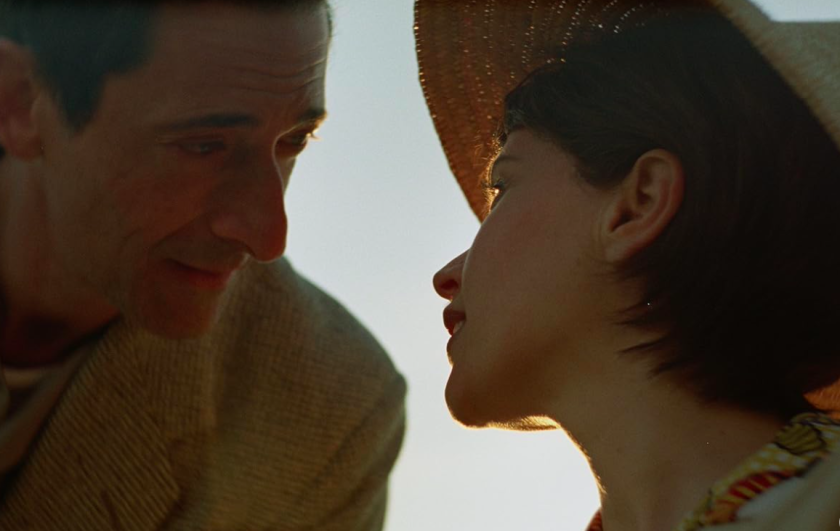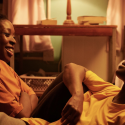There’s a moment, as we build to a climax in Brady Corbet’s first film, The Childhood of a Leader (2015), when a servant at a grand house unwittingly nudges a candle into the path of a dangling curtain pull. The tassel ignites, unseen by gathering dinner guests.
Then something happens that’s rare in the annals of film. In fact, nothing happens. The drapery is not particularly flammable and, unseen by anyone in a lingering wide shot, burns itself quickly out. This dog-that-doesn’t-bark, tree-falls-in-a-forest moment is, it turns out, signature Corbet.
He’s a maker of perplexingly non-flammable films that require either patience and study or arm-waving annoyance – nowhere more so than in his third film, the three-and-a-half-hour The Brutalist, about a curmudgeonly Hungarian architect making his way in post-war America. Corbet’s stuff moves with a halting step, full of the warp and weft and misreadings and wrong turnings of life. Critical moments happen off-screen and key lines and incidents can barely be noticeable.
There’s an obscured sense of this-leads-to-that or this-signals-the-other. Subtext is not winked at – yet “meaning” is sometimes laid on with a trowel via a voiceover or a speech, as if someone is giving a lecture on the film. Indeed, at the end of The Brutalist, we get an actual lecture summing up the whole point of the architect’s journey.
Adrien Brody plays the fictional László Tóth, a once-feted Jewish builder who escapes the 1940s European maw to find work with his cousin designing a modernist library for a Philadelphia plutocrat, Harrison Lee Van Buren (Guy Pearce). Van Buren hates the library and László’s cousin kicks him out of his home over an off-screen pass László allegedly makes at his shiksa wife. This chat-up seems unlikely, but you can’t really tell. After a chunk of time with the cousin and his wife (Alessandro Nivola and Emma Laird), the couple disappear from the film.
The bulk of the action happens after Van Buren finds that László was once a lauded genius, and resolves to laud himself as an East Coast Medici and hire the Hungarian back to build a community centre and church next to his fin-de-siècle mansion. László comes up with an ultra-boxy concrete colossus that’s like an advance parody of London’s “brutalist” Hayward Gallery.
It may be that Van Buren – an artistically curious philistine – is the true brutalist of the title. Pearce plays him with delicious, F. Scott Fitzgerald-like purring entitlement, and gives him gruff, clipped tones like Carter Pewterschmidt, the ridiculously upscale dad of Lois in Family Guy. From this point on, much screen time is taken up with planning and construction mundanities, plus meddling in the prickly László’s work, which may be Corbet’s private commentary on the trials of filmmaking.
But the other big departure is an arrival, as László’s wife Erzsébet (Felicity Jones) turns up from Europe. The couple were separated in the post-war chaos and she is in a wheelchair, struck with osteoporosis induced by famine. “Can’t you say anything kind to me?” she demands of her husband almost at once. “I love you, you cow,” he replies, setting the tone for a sexually fraught union that will wane and wax as László’s hulk of a new structure – with its giant central tower – rises up.
The brilliant Brody gives us an utterly immersive László, a contrarian buried within himself, torn in half by living backwards and forwards in history, and as miserable throughout as a leftover dog biscuit. Jones gives us both warmth and an etoliation of spirit, things she has in common with the film itself.
But Brody’s expansive, Methody acting style is at odds with the more measured, classical approach of the other cast, which challenges Corbet’s shooting preference for long, open takes. It seems he has to cut in more back-and-forth angles than in his earlier films to get things gelling. A tremendous score by Daniel Blumberg, ranging from chugging, subterranean brass to tinkling piano, reflects the grand and the everyday that prods humanity on. (The film is dedicated to the late, great Scott Walker, composer for Corbet’s first two movies.) Lol Crawley photographed the film on lushly period VistaVision stock.
Longueurs are a feature of the middle section, which nevertheless moves along faster than you might expect. Like other arty directors, Corbet loves playing with “film time”, stretching things out and then suddenly jumping onwards. (Film time, paradoxically, can go faster when nothing much is happening. It’s tension and suspense in a regular movie that can make it crawl to a stop. Time might go slower when you’re having fun.)
Although Corbet tackles the largest of themes in The Brutalist – the Holocaust; American kultur and capitalism; drug use; race and assimilation; enigmas of love and sex – he does so in a typically wrong-footing, drive-by fashion. But all the threads join up somehow if you pick at them. Then, near the end, two shock events involving Brody, Pearce and Jones – curtains, as it were, actually catching fire – make us sit up.
Both these set-pieces are savagely intimate and neither is perfectly realised, yet Corbet wants us to know that life is not just an agglomeration of the small, but that big movie-style “turning points” can actually happen too, if not normally piled up at the close of a movie.
And since listing things seems Corbet-like, here are one or two more of his oddball tropes. He insists on making Raffey Cassidy play both a character and her daughter. (Here, she’s principally László’s troubled refugee niece; in Vox Lux from 2018, she was a young pop star and her offspring.) And sometimes Corbet’s love of things most filmmakers would run a mile from goes to greater extremes. For instance, he loves “travelogue” montages – simple picture-postcard shots of a pretty locale like Venice that we’re about to enter, as if inspired by watching a shopping channel.
Finally, and most mensch-like, he abjures the possessory title credit that all other directors crave. So The Brutalist is “a film by Brady Corbet and Mona Fastvold”. Fastvold is his regular co-screenwriter, and between them they’ve fashioned a cumbrous, oblique, mesmeric portmanteau of a dismembered American Dream.














Add comment